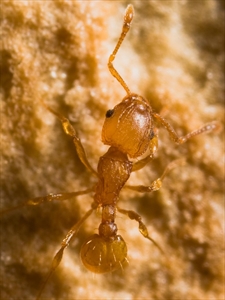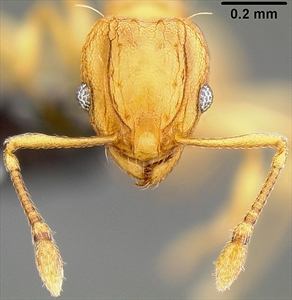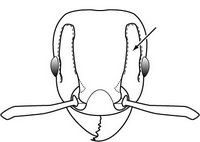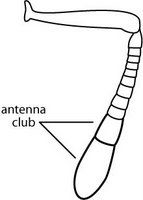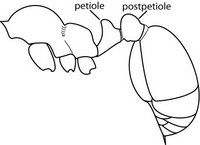Little fire ant, electric ant
Pacific Pests, Pathogens and Weeds - Online edition
Pacific Pests, Pathogens & Weeds
Little fire ant (182)
Wasmannia auropunctata
Southeast Asia, West Africa, North (including Hawaii), South and Central America, the Caribbean, Oceania. It is a greenhouse pest in Europe and Canada. It is recorded from Australia (Queensland), French Polynesia, Galapagos Islands, Guam, New Caledonia, Papua New Guinea, Solomon Islands, Vanuatu, and Wallis & Futuna.
No specific host; the ant is a generalist.
The ant is light to golden brown, 1.5 mm long, and has a painful sting (Photo 1). An illustrated description of the fire ant with the distinguishing taxonomic criteria can be found on the website of The Pacific Invasive Ant Key (http://itp.lucidcentral.org/id/ant/pia/index.html). See under Detection & Inspection for the main features.
The nest, which occurs under leaf litter, rotten wood, sheaths of palm leaves, stones, forks of trees or clumps of grass, may contain several hundred wingless queens, workers, pupae, larvae and eggs. The ant also occurs in homes, with colonies established in furniture, food, and clothing.
Little fire ant queens produce queens without fertilization. Sterile workers are produced from eggs fertilized by males. However, some of the eggs are fertilized by males and the female genetic material is ejected, so all the offspring are clones of males.
The little fire ant eats a variety of foods, seeds, other insects and mites, decaying matter and vegetation. They also use the honeydew of many kinds of sap-sucking insects. The ability of the ant to use a range of foods increases its invasive potential.
Spread occurs in numerous ways: on floating vegetation and debris; in soil or on plants associated with the nursery trade; on camping equipment; transportation of logs, shipping containers; and via commercial and military activity.
The little fire ant does not rely on winged queens to form a new colony; once established in a new location, natural dispersal occurs by the colony radiating out from the place or origin. Its success as an invasive is helped by the fact that individuals from different colonies mix freely, forming super-colonies covering hundreds of kilometres. Its success is also helped by disturbance in the environment such as that which occurs from agriculture. This has been noticed in South America, for instance, where there have been explosions of the ant associated with sugar cane and cocoa monocultures.
Wasmannia auropunctata is well documented as the cause of devastating damage to ecological and agricultural systems, and it also poses significant human health risks. It is considered to be one of the 100 worst invasive species in the world (IUCN/SSC1 Invasive Species Specialist Group). Ecological impacts include loss of arthropod (insects, including native ant species and spiders), bird and retile diversity (including decline of tortoises in the Galapagos Islands), either because they are attacked or because of habitat loss.
Impacts on agriculture are less direct: farmers do not like to work in infested gardens, and there are outbreaks of insects tended by the ant - soft scales, aphids, leaf and plant hoppers, in particular - as the ants protect them from their natural enemies. In houses, the ants infest clothing, beds, furniture and food, and are known to cause blindness in cats and dogs. The little fire ant has a painful and long-lasting sting. Research in Solomon Islands has shown subsistence farmers spend less time in their gardens, which directly effects productivity. Additionally, garden land is cropped for long periods, with increasingly lower yields, because subsistence farmers fear moving to new areas requires cutting down trees that harbour the little fire ant.
Look for a small pale coloured ant with the following characteristics: (i) two waist segments; (ii) a long backward pointing spine; (iii) antenna clubs with two segments, and a total of 11 segments; (iv) slightly concave areas on the sides of the head, from the base of the antennae almost to the back of the head, known as the 'scrobe' (see Photos 3&4; Diagrams 1-4). The little fire ant is similar to species in the genus Tetramorium, and previously was called Tetramorium auropunctata . Because of the similarity, it is best that samples are examined by a taxonomist to be sure of their true identification.
For monitoring purposes, peanut butter followed by honey is an attractive bait to foragers (Photo 2). Tuna oil has also been used. Peanut butter baits can be made by coating 30 cm kebab sticks with peanut butter and placing them vertically in the ground every 3-4 m along transects.
BIOSECURITY
Countries that are still free of Wasmannia, but vulnerable to its introduction, need to: (i) define the risk; (ii) have preventive measures in place against an introduction occurring; (iii) have quarantine protocols enacted in case a breach occurs; and (iv) be able to effect a rapid response against this ant and others. It is important to have rapid response procedures in place to be undertaken if the ant is found and eradication is a possibility. In addition, it is necessary to have biosecurity regulations to prevent movement of the ant within the country, especially in Pacific island countries where most are island groups or archipelagos. Finally, monitoring is required on the islands still free from infestation.
Ant eradication is expected to be more successful on small islands or in isolated areas where ants cover less than a dozen hectares. Evidence for this comes from the situation in the Galapagos Archipelago and Hawaii, where eradication in the larger islands is now unlikely. The situation highlights the importance of early intervention. Attempts to eradicate after the ant is well established are likely to impact non-target species, and do more harm and good.
CHEMICAL CONTROL
Three types of chemicals are used against ants: (i) stomach poisons. e.g., Maxforce® (fipronil), Amdro® (hydramethylnon), and borax; (ii) insect growth regulators (e.g., Engage® (methoprene), and Distance® (pyriproxyfen); and (iii) poisons that work on the nervous system, that is, neurotoxins, e.g., bifenthrin, fipronil, and imidacloprid. Stomach poisons kill all queens, intercastes and workers; insect growth regulators stop the queens from laying eggs, whereas neurotoxins disrupt insects' central nervous system. It is likely that future products will combine toxins that cause rapid death and insect growth regulators, e.g., Extinguish Plus® (hydramethylnon and methoprene).
A note of caution: Although it is possible to combine a lure (such as peanut butter, fish, sugar, etc.) with a pesticide as an ant bait, it is not recommended because of the danger in leaving concentrated pesticides unattended in the environment, including dwellings.
Treatment options (and case studies) are provided in the Pacific Invasive Ant Toolkit under (http://piat.org.nz/getting-rid-of-ants).
The IUCN/SSC Invasive Species Specialist Group website should be consulted for details on all aspects of eradication and management of Wasmannia and other ants (http://www.issg.org/).
____________________
When using a pesticide (even a biopesticide), always wear protective clothing and follow the instructions on the product label, such as dosage, timing of application, and pre-harvest interval. Recommendations will vary with the crop and system of cultivation. Expert advice on the most appropriate pesticide to use should always be sought from local agricultural authorities.
AUTHOR Grahame Jackson
1International Union for Conservation of Nature/Species Survival Commission. Information, photos (and Diagrams) Wasmannia auropunctata (PIAkey - identification guide to invasive ants of the Pacific islands. (http://itp.lucidcentral.org/id/ant/pia/index.html); and Electric ant. Wikipedia. (https://en.wikipedia.org/wiki/Electric_ant); and Fasi J, et al. (2016) Subsistence farmers' management of infestations of the little fire ant in garden plots on Bauro, Makirta Province, Solomon Islands. Human Ecology 44: 765-774; and from (including Photos1-8) Walker, K. (2006) electric ant (Wasmannia auropunctata): PaDIL - http://www.padil.gov.au.
Produced with support from the Australian Centre for International Agricultural Research under project PC/2010/090: Strengthening integrated crop management research in the Pacific Islands in support of sustainable intensification of high-value crop production, implemented by the University of Queensland and the Secretariat of the Pacific Community.
